Ironweed has been the bane of existence for ranchers for years, but this misunderstood wildflower should be cherished and not whacked down with reckless abandon.
There are more than 500 varieties of Ironweed or Vernonia genus of plant. It has been harvested for its medicinal properties for centuries, especially by Native Americans.
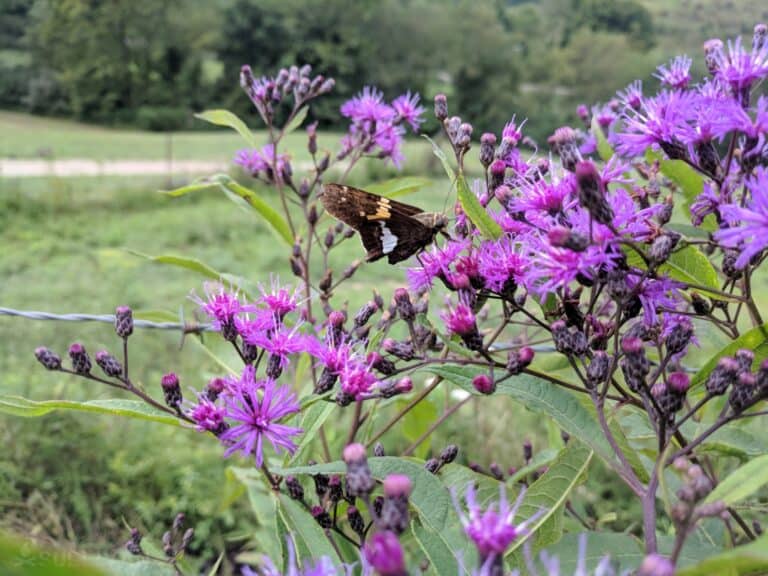
Most Common Varieties and Cultivars
| Tall Ironweed – New York Ironweed – Giant Ironweed | Yellow Ironweed |
| Veronica Revoluta | Veronica Occulta |
| Veronica Bottae | Veronica Monantha |
| Vernonia Amygdalina | Vernonia Galamensis |
| Smooth Ironweed | Vernonia Polysphaera |
Click here to see a full list of all the wonderful weeds that comprise this classification of plants.
The genus is named after early 1700s English botanist William Vernon who “discovered” these native plants during a tour of North America. The common Ironweed nickname refers to the hardiness of the plant.
Ironweed is part of the Aster family (asteraceae) which is one of the largest angiosperm families consisting of over 23,000 species. They are related to the sunflower and daisies. However, unlike those two species, the Ironweed plant has tubular flowers.
Its strong and flexible stem takes a huge amount of effort to break and it can thrive in even the most inhospitable of ground and weather conditions.
While it is true that the ironweed plant is not nutrient rich like other natural matter growing in a pasture or hay field, farmers and ranchers have no need to worry about the plant being harmful to livestock.
But, it does spread both quickly and easily because the fine seeds are dispersed by even a slight wind.
The most prevalent variety of Ironweed in the United States is referred to as “Tall Ironweed.” It is the most easily identifiable form of the plant with its bright and bountiful little purple flowers.
Not having any toxic look-alikes makes this version of ironweed a superb foraging item for beginners.
While the Cherokee people used the deep purple flowers of Tall Ironweed plants as a nicotine free form of chew, it is the root that boasts the natural medicinal properties in this so-called weed.
Ironweed grows in fields, pastures, and ditches in the entire eastern United States, the South, and the Midwest – as well as some regions in the West. It prefers full sun areas in moist soil, but will grow in partial shade, in dry or even on rocky ground.
All varieties are great attractors of pollinators. If you decide to plant ironweed as part of your survival apothecary plan because it does not grow naturally where you live, situate it around the border of your garden to help your other crops thrive.
Planting several rows of Ironweed in or around your survival garden should attract plenty of butterflies like Monarchs, bees, swallowtails, skippers.
Adding American Painted Ladies to the area will help your crops grow to provide nectar or all of those species.. Ironweed is a superb companion plant for Culver’s Root.
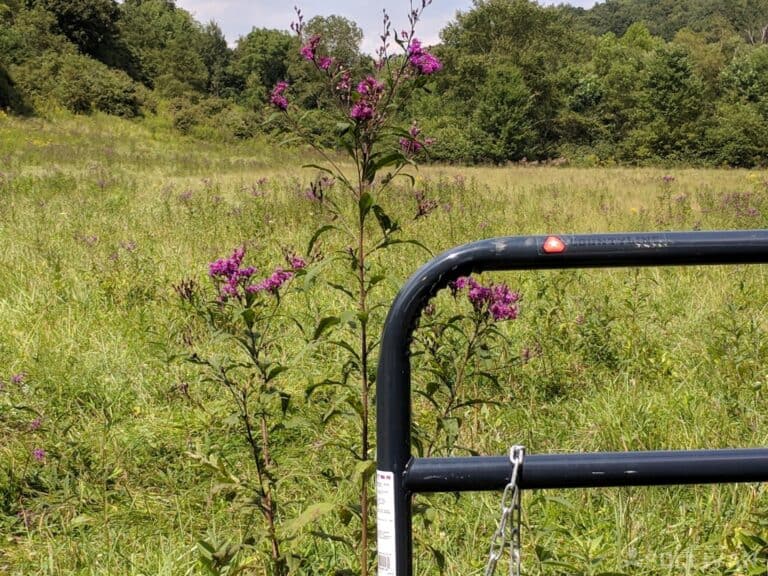
You can easily harvest seeds from ironweed plants during the early weeks of fall, or purchase ironweed seeds online if harvesting is not an option.
Disclaimer
Like all natural home remedies and supplements, ironweed has not been approved by the federal Food and Drug Administration (FDA) for use as a medicine. I am not a medical professional of any type. I am merely sharing the results of my own experience and research for educational and entertainment purposes.
Always consult your doctor before using a natural remedy. Simply because the ingredients are natural and come from the earth does not mean they are safe for everyone to use.
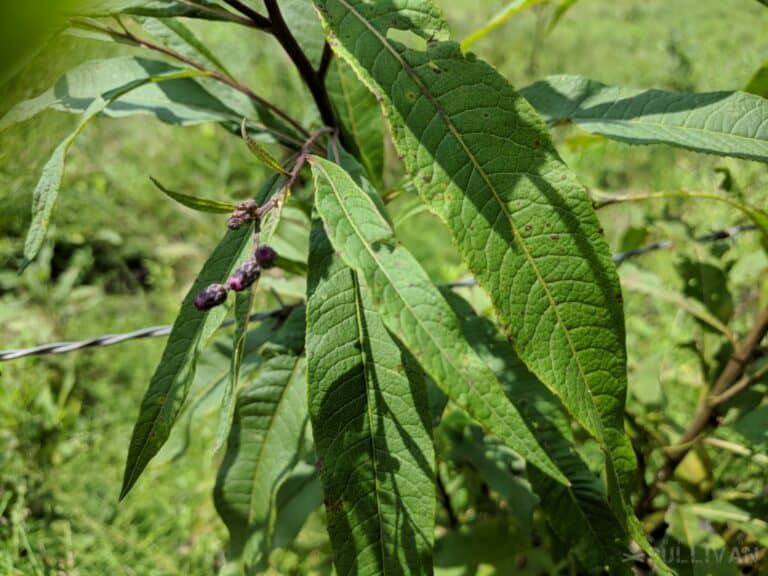
Ironweed Identification
- You may find just a single Ironweed plant nestled among JoePye weed or goldenrod plants, or a large spread of them that could stretch nearly one acre – thanks to the easy and broad natural seed disperal of the plant.
- Ironweed is primarily a weedy composite plant that has alternating leaves throughout the stem with tubular flower heads commonly found in shades of purple, red, white, and yellow.
- It is a perennial plant.
- Bracts at the base of ironweed plants are broad, pointy, and spreading.
- Leaves are serrated, blade shaped and somewhat hairy in texture. The ends of the leaves converge in a sharp point, resembling the end of a knife.
- Depending on the climate and type of ironweed being cultivated, the plants can grow to be 2 to 3 feet wide. Tall Ironweed tends to be slightly less full than other types of plants in this same category.
- Ironweed blooms from May through September in most climates.
- Leaves range in size from about 3 to 10 inches long – with 6 inch leaves being the most common across varieties in this genus. They are quite fuzzy on the undersides of the leaves due to dense white hairs on them.
- The height of Ironweed plants varies by variety. The most common, Tall Ironweed, typically stands between three to 10 feet tall, depending upon the maturity of the plant. Some varieties grow to only reach 3 feet tall.
- The tiny and delicate looking flowers on ironweed plants typically appear in groupings of approximately 40 on each flower head.
- Every flower has 5 stamens, a pistil, a style, 5 lobed and tubular corolla, and an inferior ovary.
- They grow best in moist soil but will be able to tolerate clay or loam if that is what is around them.
- The width of ironweed plants ranges from approximately 1 foot to nearly 3 feet wide. Tall Ironweed is about 1 foot wide while Yellow Ironweed, which is also fairly prevalent in America, is close to 2 feet wide.
Depending upon both your tastebuds and the variety of ironweed that you forage as a part of our survival plan, the flavor can range from deliciously sweet to somewhat bitter.
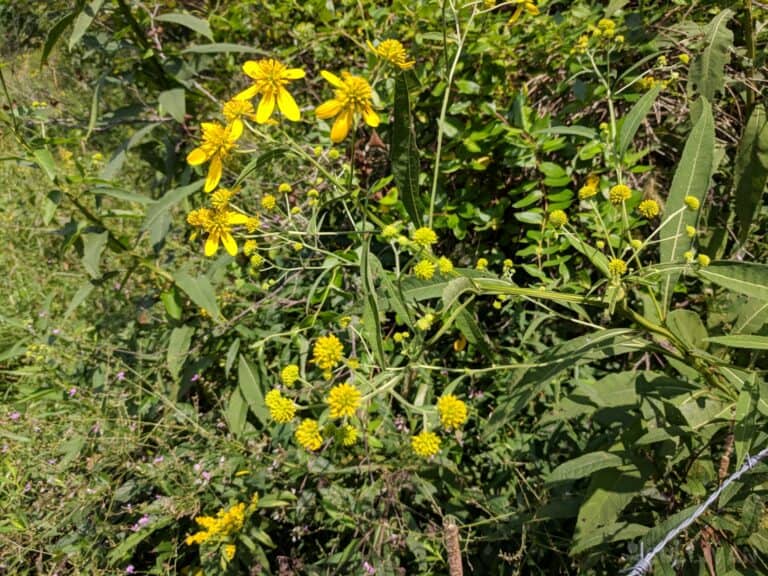
When foraging, always make sure you are harvesting only plants that you are certain were never sprayed with chemical weed killer or similar unnatural concoctions.
Never pick all of the Ironweed (or anything) from an entire patch or risk losing the whole wild crop for the following year.
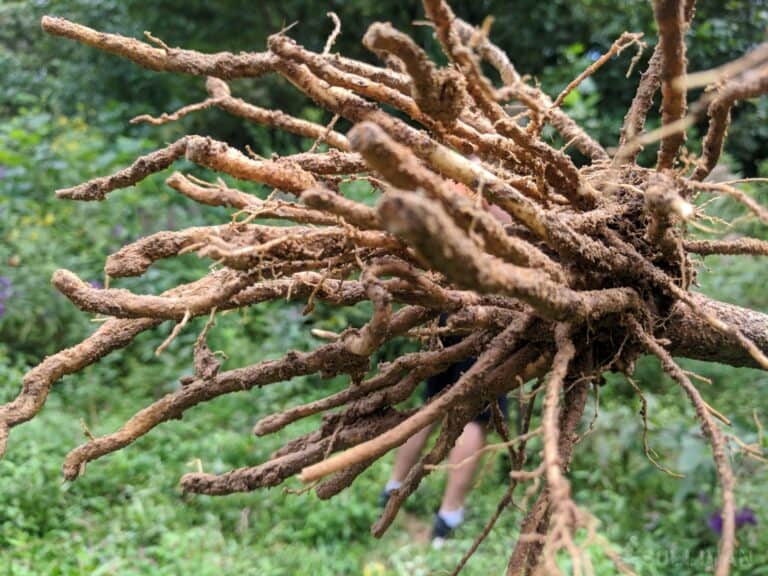
How to Harvest Ironweed Root
Pulling the plant directly out of the ground is beyond unlikely to happen, even with young plants growing in moist dirt. You will need at least a small shovel to dig out the dirt surrounding the base of the plant to harvest the root.
1. First, loosen the soil all the way around the bottom of the stem. The root is not wide, but still begin loosening the dirt about five inches away from the stem.
2. Once the dirt has been loosened, dig straight down – angling could nick the root, about 12 inches.
3. Rock the shovel back and forth to dislodge the plant without disturbing the root and breaking part of it off.
4. Grasp the lower stem firmly and pull it out of the ground
5. Cut the root free from just below the bottom portion of the stem:
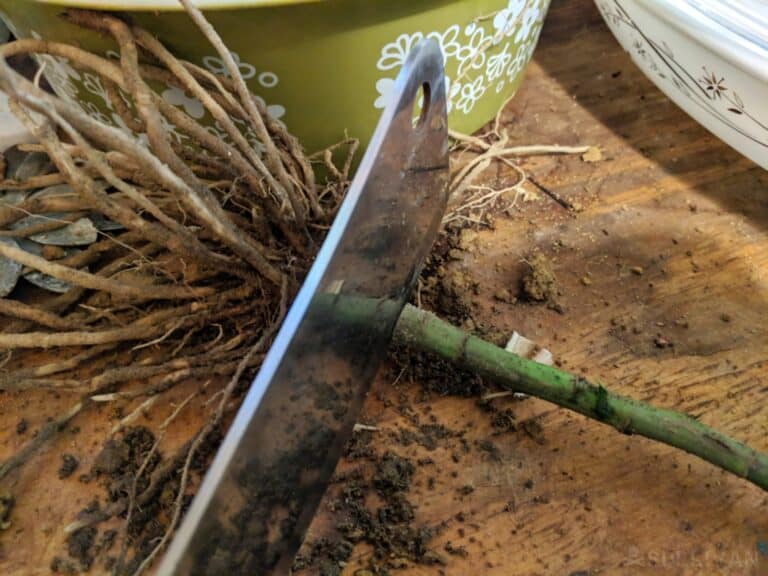
The stem is thick and durable, it will likely take several whacks with a meat cleaver to cut away the root from the stem of the ironweed plant.
6. Wash the root in Lukewarm water to remove dirt and debris:
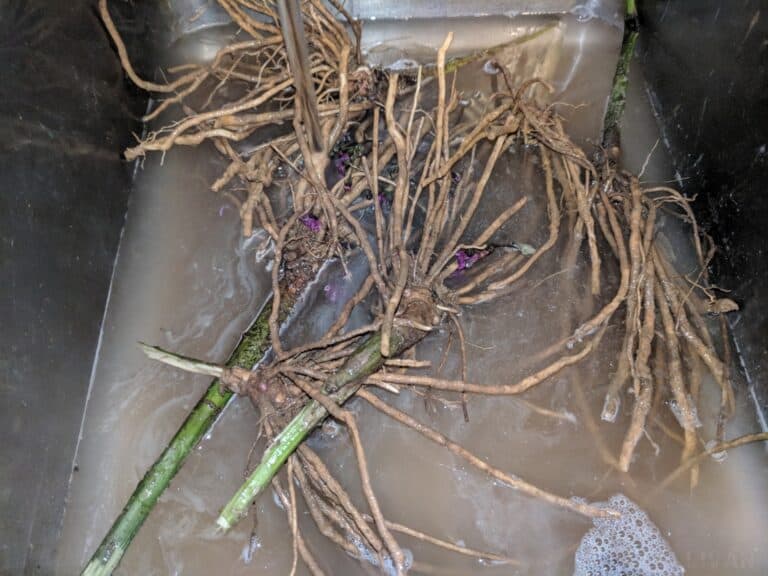
Ironweed Cultivation Tips
- Ironweed plants are perennials that bloom from May through the late summer into September in most climates. The lance shaped serrated leaves are pointy at both ends and grow to between three and 10 inches as they alternate up the stem.
- The Tall Ironweed flowers are purple in color and are nearly too numerous to count on the flower head. Typically, ironweed grows in clusters, but because the seeds are sown easily by the wind, one or two plants can pop up just about anywhere. Harvesting the seeds
- Ironweed can be grown in a container garden, but it is best planted directly into the ground. If planting in containers,
- Tall Ironweed is hardy in United States Department of Agriculture (USDA) Zones 4 through 9.
- This wonderful weed prefers full sun but can thrive in partial shade, as well.
- For best results, plant ironweed seeds in a soil that is well draining. This is a hardy plant that can still flourish in dry or even gravel type of soil. It literally grows in every type of dirt we have on our survival homestead.
- The only two types of plant diseases ironweed is truly susceptible too are rust and powdery mildew.
- Tall Ironweed typically grows to reach heights of 7 to 12 feet tall. Other varieties of this wild plant range in height from three to about 10 feet tall.
- Ironweed seeds and cuttings do best in a soil that has a pH balance of 6/1 to 7/5 is high.
- The common seed germination time is approximately 2 to 3 weeks.
- If planting or transplanting in the spring, you should achieve best results when the air temperature averages between 65 degrees F.
- If Ironweed starts growing in places that you don’t want it to then any unwanted seedlings can be easily pulled out in the springtime.
How to Harvest and Stratify Ironweed Seeds
Ironweed seeds are the white fluffy part inside of the hardened flower petals after the plant has “gone to seed.” You simply – yet carefully, peel back the hardened outside covering of the flowerhead to expose the seeds to harvest them for planting.
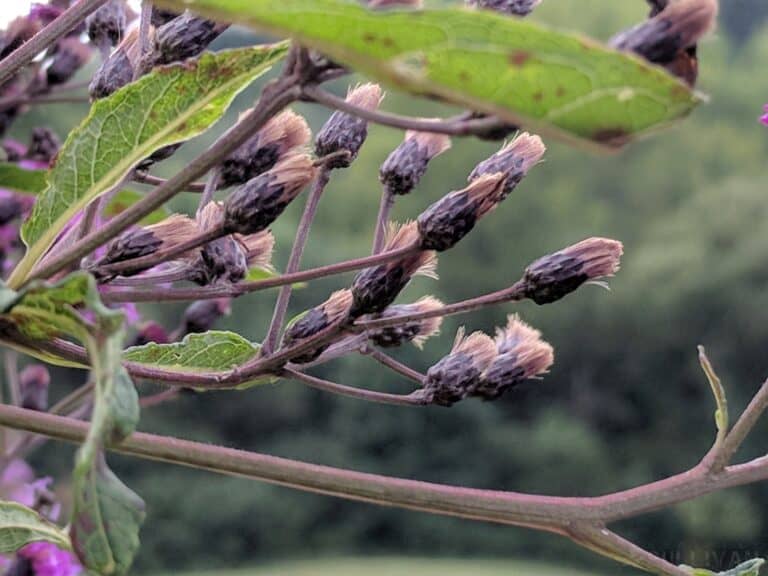
When storing seeds after harvesting them in the early fall for spring planting, cold stratify them for 60 to 90 days for best results. To stratify the seeds, lay them flat inside of a Ziploc freezer bag and put them immediately in the refrigerator to prevent them from drying out.
Some folks alternate keeping the seeds in the refrigerator for a few weeks and then move them to the freezer for a few weeks and then back to the refrigerator again to mimic the changing of the seasons.
How to Grow Ironweed
Ironweed should be planted in the ground through early weeks of spring when being cultivated from seed. Seeds can winter over in the ground when planted in the fall, but can also be started indoors and transplanted during the spring.
Plant the seeds in a humus rich and moist well-draining soil for best results.
If starting the Tall Ironweed plant from a cutting, it is essential to start it in full sun after the final threat of a frost has passed in the spring.
Seeds should be kept damp for the duration of the germination process.
When sowing Tall Ironweed seeds directly outdoors in the spring, plant them between one to two feet apart. I recommend waiting until the seeds develop a plant that is two inches tall before transplanting outdoors.
Plant each tiny little white fluffy seed only one-eighth to one-fourth of an inch in the ground. Some folks sow the seeds directly on top of tilled ground. Seeds spread naturally when just a slight wind blows once they are ready to be harvested.
To keep your perennial ironweed plants healthy, divide them up about every three to four years. To do this, dig up the root of the plants carefully and cut away any dead portions of both the root and crown.
They typically show signs of decay in the center of the root. Next, cut up the root in chunks and replant in fresh soil.
How to Take Cuttings From an Ironweed Plant
If you want to grow ironweed plants from cuttings instead of seed, take the cuttings during the final weeks of spring when the wild plant is once again actively growing.
- Cut about five inches from a healthy stem and remove the leaves from the bottom two inches.
- Dip the ironweed cutting in a rooting hormone to help encourage the formation of a solid root – optional but recommended.
- Put the cutting up to the leaf level, in quality humus rich and well draining soil.
- Keep the soil moist but not damp as the cutting begins to take root.
Ironweed Preservation
To preserve the root for future use, dehydrate it as you would the leaves after chopping it into like-sized chunks. It will take nearly double the time to dehydrate a root.
When making tea right away, simply chop the root into small bits and brew it.
If you want to powder the ironweed root so it brews and dehydrates more easily – and takes up less storage space, just chop it as noted above and run it through a blender or food processor on pulverize mode for a minute or two:
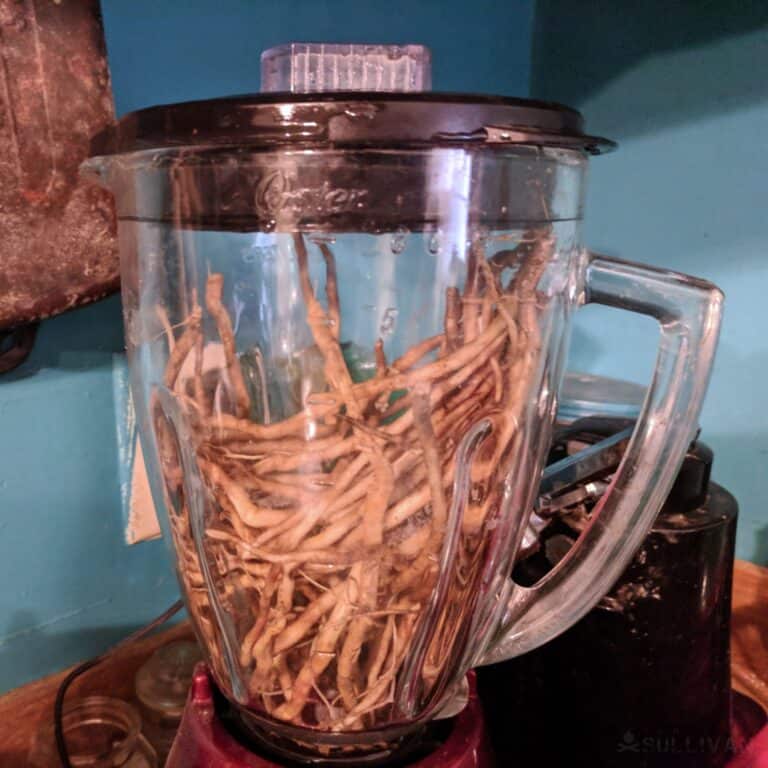
This is what the powder should look like:
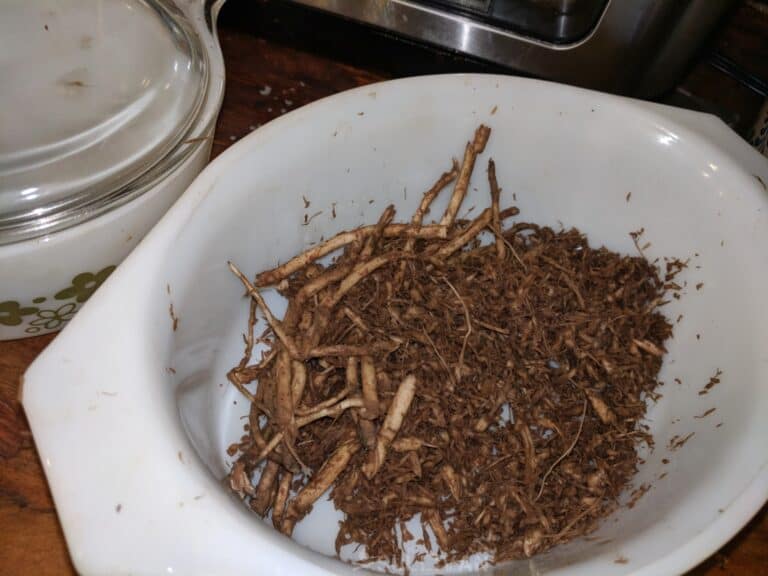
How to Dry Ironweed Leaves
When using a dehydrator, place the leaves on the trays so they are separated enough to facilitate good air flow.
Use the nuts and herbs heat setting on your machine. Dehydrate the ironweed leaves for about 3 to 4 hours until they are dry to the touch and crisp.
In the oven, set the temperature at 150 to 170 degrees F (65 to 75 C). Space the ironweed leaves onto a baking sheet (or metal cooling rack on top of a baking sheet) and dry them for about 2 to 4 hours.
To dry ironweed leaves to make tea outdoors using the power of the sun, place them on top of a cooling rack with either aluminum foil beneath a baking rack – or both.
Place a piece of screen or hardware cloth (rabbit hutch wire) on top of the leaves. Put a stone or brick piece heavy enough to prevent the makeshift solar dehydrator from blowing or tipping over, on top.
Depending upon the temperature and humidity, expect it to take about 8 to 10 hours to dry the freshly picked ironweed leaves.
Pests
Japanese beetles are about the only garden pests that are attracted to hardy ironweed plants. Be on the lookout for these metallic beetles throughout the growing process.
I sprinkle flour or diatomaceous earth onto the leaves of the plant to kill the beetles. Once they consume either of these, it causes them to dehydrate and die.
You generally don’t have to worry about deer or rabbits eating up your Ironweed crop since they stay clear of it most of the time. This is due to the bitter taste that the leaves provide, which is off putting for many creatures.
If you cannot find ironweed growing naturally where you live to harvest seeds from, they can be purchased from some online garden suppliers.
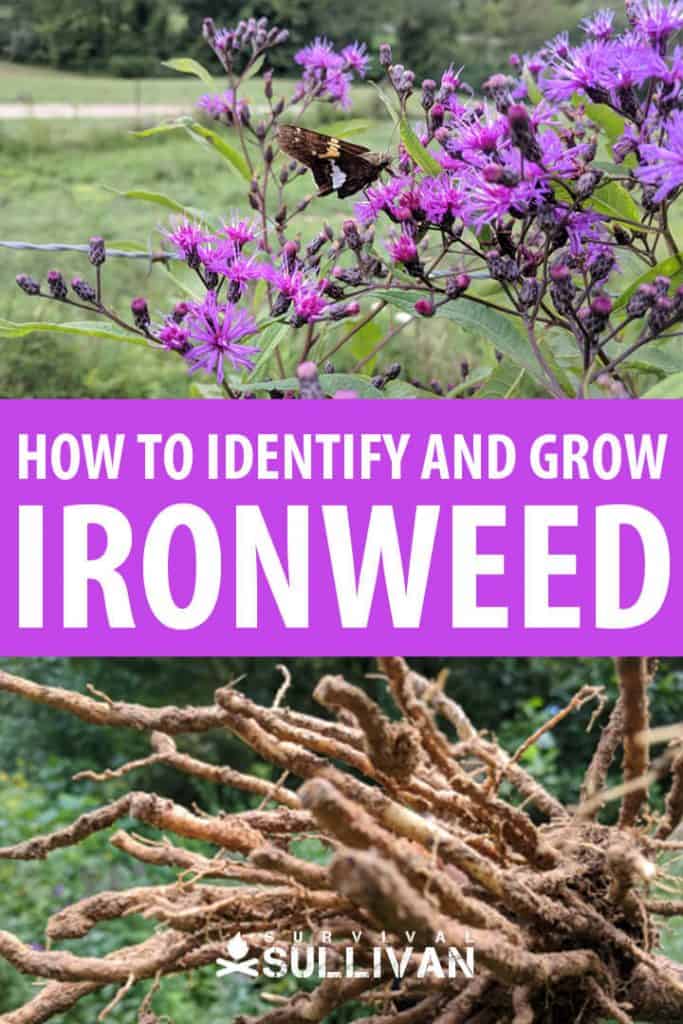

Tara Dodrill is a homesteading and survival journalist and author. She lives on a small ranch with her family in Appalachia. She has been both a host and frequent guest on preparedness radio shows. In addition to the publication of her first book, ‘Power Grid Down: How to Prepare, Survive, and Thrive after the Lights go Out’, Dodrill also travels to offer prepping tips and hands-on training and survival camps and expos.

Could you provide more information on how to grow Tall Ironweed in a container. I have received 4 plants about 4-5″ tall that unfortunately I will not be able to plant in the ground and I would like to plant them in containers. I need any advice, recommendations, or caveats that you could provide. I realize that this is not the ideal situation for this plant.